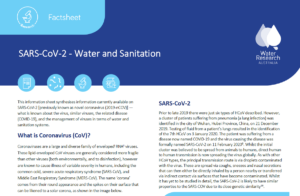From the Australian Water-Wastewater Association…
 What is Coronavirus (CoV)?
What is Coronavirus (CoV)?Coronaviruses are a large and diverse family of envelopedi RNAii viruses. These lipid-enveloped CoV viruses are generally considered more fragile than other viruses (both environmentally, and to disinfection), however are known to cause illness of variable severity in humans, including the common cold, severe acute respiratory syndrome (SARS-CoV), and Middle East Respiratory Syndrome (MERS-CoV). The name ‘corona’ comes from their round appearance and the spikes on their surface that can be likened to a solar corona, as shown in the image below.
Some coronaviruses can potentially survive in the gastrointestinal tract and be spread by the ‘faecal-oral’ route or via inhalation of contaminated wastewater droplets. There have not been reports of faecal-oral transmission of COVID-19 to date12. Two studies have reported detection of SARS-CoV-2 fragments in faecal matter of COVID-19 patients13,14. Whilst plausible, because it’s newly discovered, it is not yet certain how well the virus is able to survive in water and wastewater. However, nasal secretions are found in wastewater (e.g. due to flushing of tissues) and most likely SARS-CoV-2 will enter wastewater systems. Furthermore, the most similar virus tested, SARS-CoV, was shown to be present in wastewater and to persist in faeces, urine, water and wastewater for periods up to 2 days at 20°C, at least 14 days at 4°C, and survive for 4 days in diarrheal stool samples with an alkaline pH at room temperature9,11.
Based on this, it is possible that SARS-CoV-2 may be present in wastewater where COVID-19 infections are present. Importantly, the same is true for a wide variety of pathogens, such as other viruses, bacteria and protozoa. The controls already in place to protect persons working around wastewater are based on keeping workers safe from much more readily transmissible and established faecal-oral pathogens (such as norovirus, adenovirus, hepatitis A virus, Cryptosporidium, Giardia and Campylobacter). The key point is that existing, standard approaches, already used for working safely with wastewater, still apply, and no special or specific changes need to be made due to the SARS-CoV-2. The SARS-CoV-2 is just one of many pathogens including viruses potentially present in wastewater. Exposure to all pathogens in the workplace and in wastewater should be managed by ‘business as usual’ hygiene practices (see below).
Water utilities and their contractors should continue to provide safe working environments by following conventional precautions for working with wastewater. This involves providing the appropriate tools, equipment, work methods and procedures, personal protective equipment and sanitation for all workers. In addition, providing advice, such as this fact sheet, is important, to avoid unnecessary concern.
‘Business as usual’ hygiene practices
The design and operation of processes used for the disinfection of water and wastewater is based on the most resistant pathogens present. Fortunately, coronaviruses are not among those most resistant to disinfection processes. That means that conventional disinfection methods, applied to inactivate the more resistant viruses, would be expected to readily inactivate SARS-COV-2.
For oxidant (chlorine, monochloramine and chlorine dioxide) disinfectants, the more resistant non-enveloped, protein capsid coated viruses, such as hepatitis A virus and coxsackieviruses, have historically been used to set the design and operational requirements for disinfection. The lipid-enveloped CoV viruses are typically more sensitive to these disinfectants. For instance, the virus most closely related to SARS-CoV-2, being SARS-CoV, was found to be very sensitive to chlorine and chlorine dioxide disinfection (as sensitive as E. coli and coliphage).9
For UV irradiation, double-stranded DNA viruses, such as adenoviruses, have historically been used to set the design and operational requirements for disinfection. The CoV viruses have large single-stranded RNA genomes and are considerably more sensitive to UV disinfection.
Given the above, it is considered that conventional disinfection of water and wastewater, designed and operated to meet current standards, guidelines and validation approaches, will be more than adequate to control transmission of SARS-CoV-2 via drinking water, recycled water and wastewater. No additional or modified treatment is required beyond the ‘business as usual’ treatment currently applied to manage such transmission risks.
Standard water and wastewater treatment and disinfection processes used to control pathogen transmission via water routes are expected to be effective on SARS-CoV-2. No changes are required.
Download the Australian Water-Wastewater Association fact sheet (pdf)